by Lisa Cooke | Jul 8, 2015 | 01 What's New, Church, Irish, Libraries, Records & databases
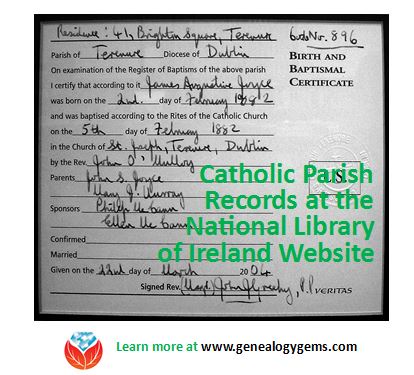
Writer James Joyce’s baptismal certificate; click to link to Wikipedia image.
As of today, the National Library of Ireland expects to launch a free, digitized collection of ALL its Catholic parish registers on its website (this link takes you to the English version; it’s also available in Irish). Nearly 400,000 digital images of microfilmed parish records comprise this collection.
According to a press release, “The parish register records are considered the single most important source of information on Irish family history prior to the 1901 Census. Dating from the 1740s to the 1880s, they cover 1,091 parishes throughout the island of Ireland, and consist primarily of baptismal and marriage records….Their digitisation means that, for the first time, anyone who likes will be able to access these registers without having to travel to Dublin.”
Catholic parish registers are a vital genealogical resource. In addition to the names of those baptized or married, they usually include those event dates, names of parents of baptized children, godparents and witnesses (who may also be relatives).
NOTE: This is a browsable-only collection. There are currently no plans to index or transcribe the records. However, the press release included a great suggestion for accessing indexes: look to local family history centers for that parish or neighborhood. “The buy diet medication online nationwide network of local family history centres holds indexes and transcripts of parish registers for their local areas,” it says.
 Those unfamiliar with Ireland research may assume this means local FamilySearch Family History Centers, but a map shows only a few of these in Ireland. I would start first with the network of county genealogy centers, accessible online at Roots Ireland. According to that site, “The county genealogy centres are based in local communities, working with volunteers, local historical societies, local clergy, local authorities, county libraries and government agencies to build a database of genealogical records for their county. By using this website you are supporting that work and the communities from which your ancestors originated.” Several counties actually already have online records you can access through the Roots Ireland link above. Ancestry also has several databases of Irish Catholic parish registers.
Those unfamiliar with Ireland research may assume this means local FamilySearch Family History Centers, but a map shows only a few of these in Ireland. I would start first with the network of county genealogy centers, accessible online at Roots Ireland. According to that site, “The county genealogy centres are based in local communities, working with volunteers, local historical societies, local clergy, local authorities, county libraries and government agencies to build a database of genealogical records for their county. By using this website you are supporting that work and the communities from which your ancestors originated.” Several counties actually already have online records you can access through the Roots Ireland link above. Ancestry also has several databases of Irish Catholic parish registers.
For more tips on researching your Irish relatives, listen to the FREE Family History Made Easy podcast episode 21, in which we interviewed Irish expert Judith Wight. You’ll hear her tips on finding Church of Ireland records, civil registrations, estate records and how history helps us understand gaps in the records.
Thank you for sharing this post with those who will LOVE to know about these Irish genealogy resources!
by Lisa Cooke | Apr 22, 2019 | 01 What's New, Beginner, Brick Wall, Research Skills
Have you reached a dead end on one branch of your family tree–you can’t find the parents’ names? Check out these sources for finding ancestors’ parents.
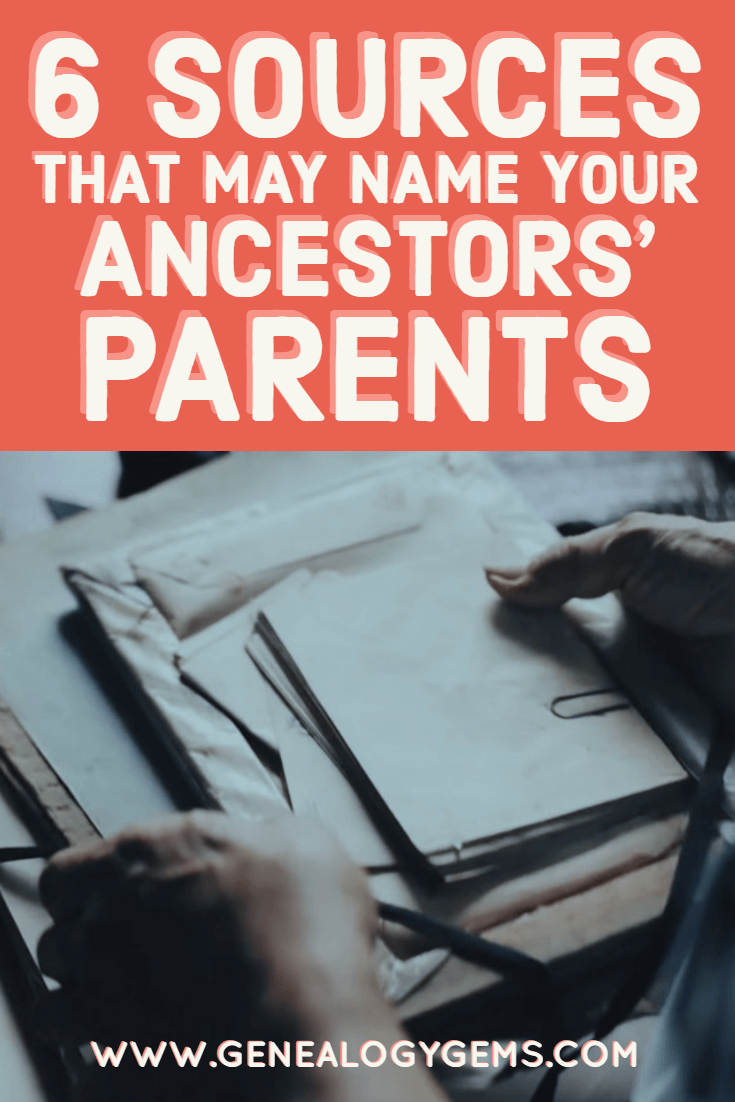
Recently Genealogy Gems podcast listener Trisha wrote in with this question about finding marriage license applications online. She hoped the original application would name the groom’s parents. Unfortunately, her search for the applications came up dry. So, she asked, “Are there other documents that would have his parents names listed on them?”
Here’s a brainstorm for Trisha and everyone else who is looking for an ancestor’s parents’ names (and aren’t we all!).
6 Record Sources that May Name Your Ancestors’ Parents
1. Civil birth records. I’ll list this first, because civil birth records may exist, depending on the time period and place. But in the U.S. they are sparse before the Civil War and unreliably available until the early 1900s. So before a point, birth records–which will almost always name at least one parent–are not a strong answer. Learn more about civil birth records in my free Family History Made Easy podcast episode #25.
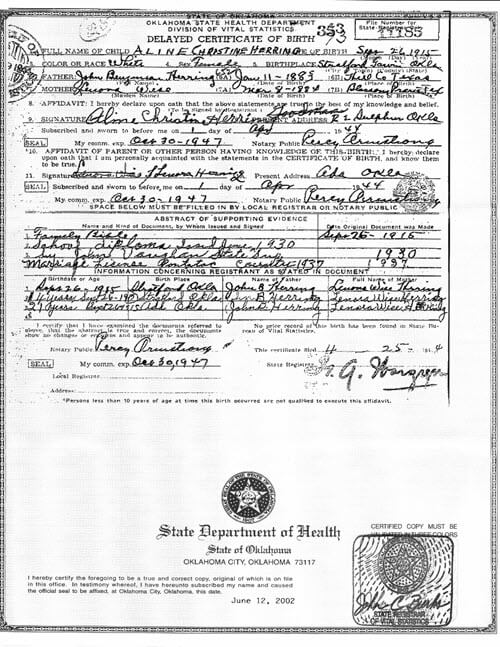
2. Marriage license applications. Trisha’s idea to look for a marriage license application was a good one. They often do mention parents’ names. But they don’t always exist: either a separate application form was never filled out, or it didn’t survive. Learn more about the different kinds of marriage documents that may exist in the Family History Made Easy podcast episode #24.
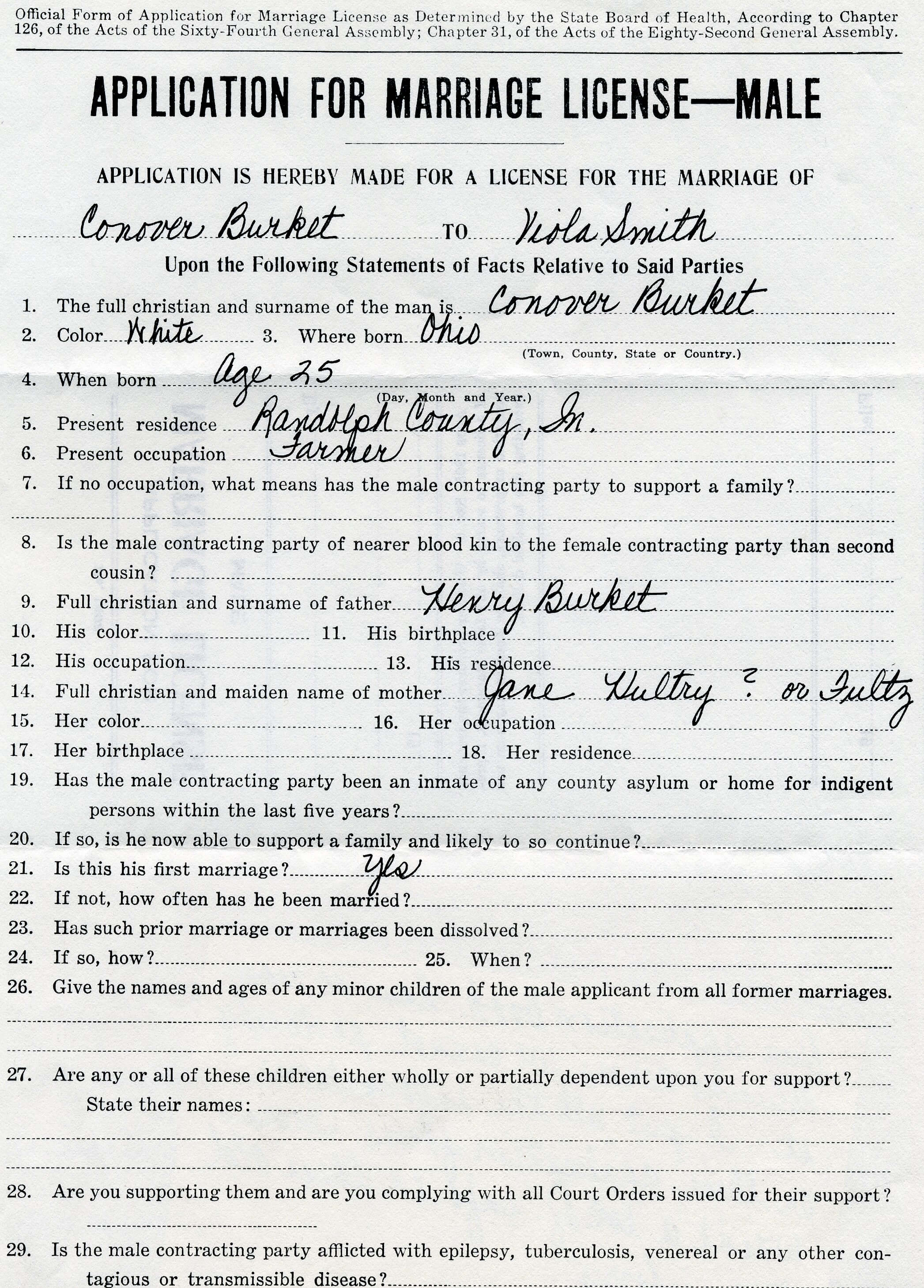
3. Obituaries. Obituaries or death notices are more frequently found for ancestors who died in the late 1800s or later. Thanks to digitized newspapers, it’s getting SO much easier to find ancestors’ obituaries in old newspapers. My book How to Find Your Family History in Newspapers is packed with practical tips and inspiring stories for discovering your family’s names in newsprint. Millions of newly-indexed obituaries are on FamilySearch (viewable at GenealogyBank). Get inspired with this list of 12 Things You Can Learn from Obituaries!
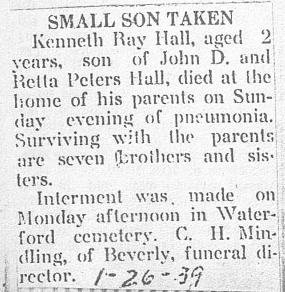
4. Social Security Applications (U.S.). In the U.S., millions of residents have applied for Social Security numbers and benefits since the 1930s. These applications request parents’ names. There are still some privacy restrictions on these, and the applications themselves are pricey to order (they start at $27). But recently a fabulous new database came online at Ancestry that includes millions of parents’ names not previously included in public databases. I blogged about it here. Learn more about Social Security applications (and see what one looked like) in the show notes for my free Family History Made Easy podcast episode #4.
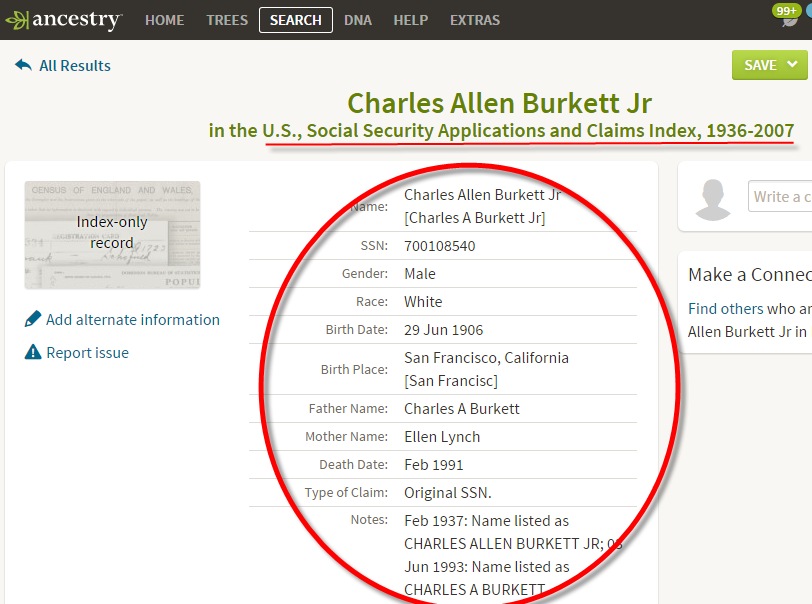
5. Baptismal records. Many churches recorded children’s births and/or the baptisms of infants and young children. These generally name one or both parents. Millions of church records have come online in recent years. Learn more about birth and baptism records created by churches in the Family History Made Easy Podcast Episode #26. Click these links to read more about baptismal records in Quebec and Ireland.
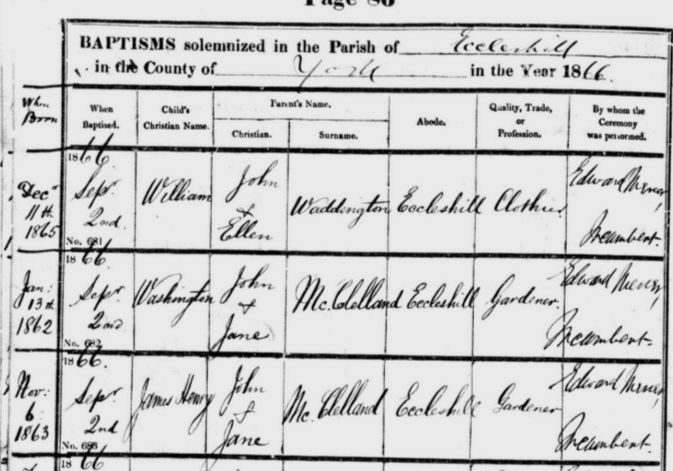
6. Siblings’ records. If you know the name of an ancestor’s sibling, look for that sibling’s records. I know of one case in which an ancestor appeared on a census living next door to a possible parent. Younger children were still in the household. A search for one of those younger children’s delayed birth record revealed that the neighbor WAS his older sister: she signed an affidavit stating the facts of the child’s birth.

Thanks for sharing this list with anyone you know who wants to find their ancestors’ parents!
More Genealogy Gems on Finding Your Ancestors in Old Records
Missing Birth Record? Here’s What You Can Do to Track it Down
Try These 2 Powerful Tools for Finding Genealogy Records Online
Finding Ancestors in Courthouse Records: Research Tips
(Premium website membership required)
About the Author: Lisa Louise Cooke is the producer and host of the Genealogy Gems Podcast, an online genealogy audio show and app. She is the author of the books The Genealogist’s Google Toolbox, Mobile Genealogy, How to Find Your Family History in Newspapers, and the Google Earth for Genealogy video series, and an international keynote speaker.
This article was originally posted on November 3, 2015 and updated on April 19, 2019.
by Lisa Cooke | Jan 4, 2016 | 01 What's New, Organization
A recent experience reminded me how important it is to invest time getting to know the things we work with–whether they’re genealogy databases or a new piece of technology.The ProblemThe other day I was trying to do something I thought was very simple:...
by Lisa Cooke | Dec 26, 2015 | 01 What's New, Ancestry, DNA, Trees
DNA Circles at AncestryDNA can get problematic when participants’ trees are unverified. This is why.

Adding people to a family tree without verifying the connection is a fairly common genealogical practice. This happens a lot when people “graft” information from another online tree.
In addition to the problems this can create in your tree, it can create problems when you start looking at genetic connections. We have received a few inquiries about this topic here at Genealogy Gems, and I chatted with a fellow genealogist about this at a recent conference.
The practice of copying online trees factors most heavily in the DNA Circles and New Ancestor Discoveries (NAD) at AncestryDNA. You will remember from our previous conversations that these tools are like parties that your DNA has secured your tickets to attend. Each of these parties is “hosted” by one of your ancestors, in the case of the DNA circle, and a presumed ancestor, in the case of a NAD. Sometimes we catch ourselves declaring that our membership in the DNA circle “proves” our connection to the party host.
But we must be careful. Because it does not.
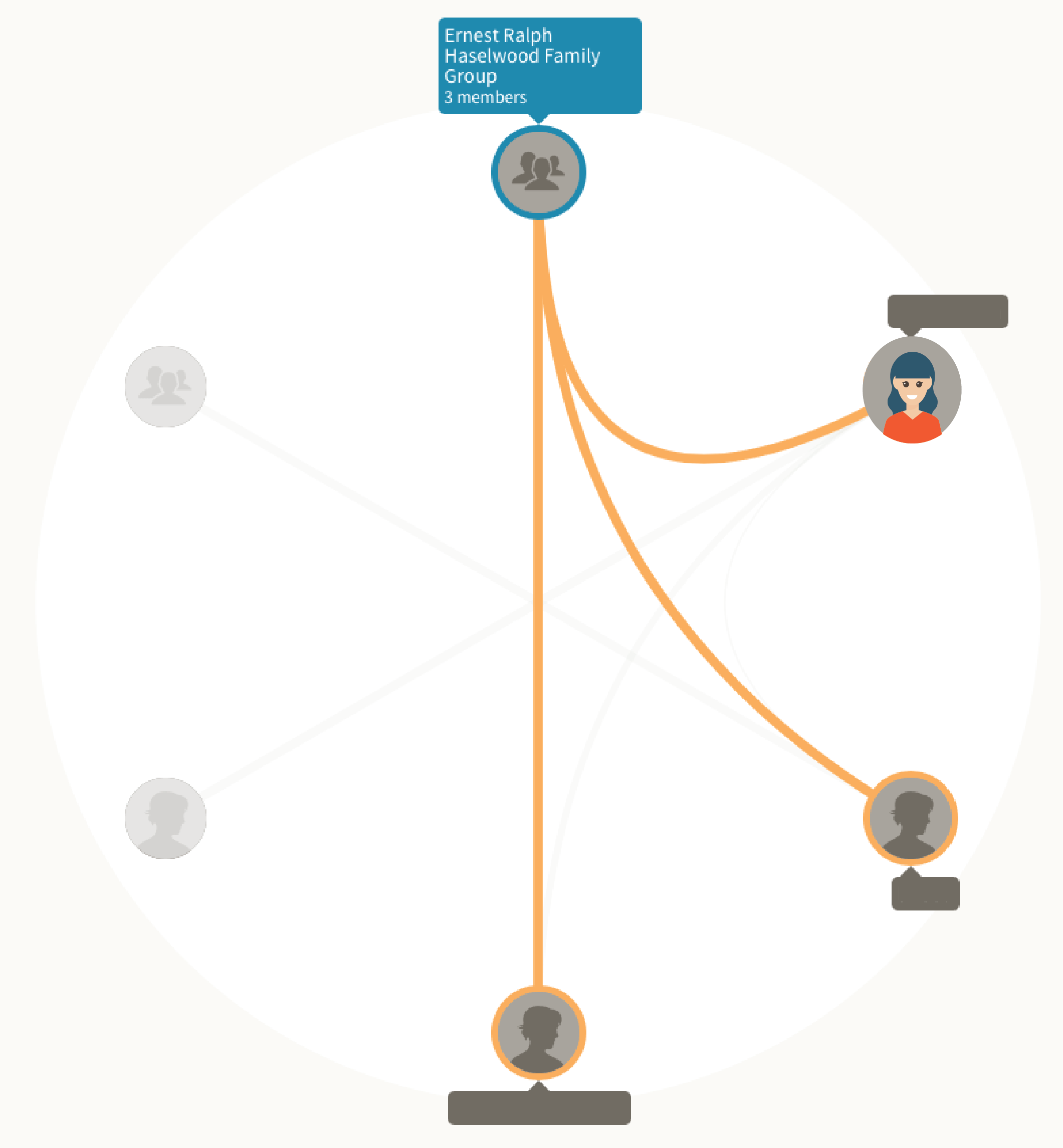 “Proves” is too strong of a word. All your membership in the DNA circle can really tell you is that you have a genetic connection to those marked with the orange line. Those with the grey connecting lines have a DNA connection to some of the circle members, but not to you. Placing the name of an ancestor on the cover of this gathering does not guarantee that the named person is your common ancestor. It is just a suggestion; a hint.
“Proves” is too strong of a word. All your membership in the DNA circle can really tell you is that you have a genetic connection to those marked with the orange line. Those with the grey connecting lines have a DNA connection to some of the circle members, but not to you. Placing the name of an ancestor on the cover of this gathering does not guarantee that the named person is your common ancestor. It is just a suggestion; a hint.
Think about this for just a second. Let’s say that Joan does a bit of research and decides that her immigrant ancestor’s father is Marcus Reese, born in 1823 in Wales. She adds this to her pedigree chart. She sees on a census record that he had four children, one of whom shared the name of her ancestor, William, and adds those to her chart as well.
Months later, Charlotte is researching her Mary Reese and sees Mary listed on Joan’s pedigree chart as the child of Marcus. She knows Mary’s father was born in Wales and adds Marcus to her pedigree chart telling herself that she will go back later and double check. And so on.
After a while, we have 7 people all connected back through Marcus and his four children, and they all independently decided to get their DNA tested through Ancestry.com.
Ancestry sees their shared DNA and that they have all listed Marcus Reese as their common ancestor. So they create a DNA circle for the seven of them, with Marcus Reese at the head.
Ancestry did not look at the number of cited sources or the myriad of other genealogical possibilities about how these seven individuals could all be related to each other. It saw a genetic connection and a genealogical hypothesis, and it presented them to you in the form of a DNA circle.
The genetic evidence supports a single common ancestor for these 7 people, but it certainly does not have to be Marcus Reese. You can become more certain as you gather the traditional genealogical evidence that you would in any other case. As your documentation mounts, so will your confidence, with the DNA acting like an invitation to keep searching for further evidence of your connection.
 If you enjoyed this post, you’ll love my series of DNA for genealogy quick guides. Each laminated guide–with quick, clear text that helps you act on what you learn–is targeted to a specific DNA topic, from “Getting Started” to the three types of DNA tests you can take to understanding your results with testing companies AncestryDNA, FamilyTreeDNA and 23andMe. Why not grab the “super bundle” of all 10 guides? You can also shop for them individually here.
If you enjoyed this post, you’ll love my series of DNA for genealogy quick guides. Each laminated guide–with quick, clear text that helps you act on what you learn–is targeted to a specific DNA topic, from “Getting Started” to the three types of DNA tests you can take to understanding your results with testing companies AncestryDNA, FamilyTreeDNA and 23andMe. Why not grab the “super bundle” of all 10 guides? You can also shop for them individually here.
Disclosure: This article contains affiliate links and Genealogy Gems will be compensated if you make a purchase after clicking on these links (at no additional cost to you). Thank you for supporting Genealogy Gems!

by Lisa Cooke | Dec 21, 2015 | 01 What's New, Holidays, Inspiration, Listeners & Readers, Writing Family History
 Why not share the gift of family history story in this year’s Christmas letter or holiday cards?
Why not share the gift of family history story in this year’s Christmas letter or holiday cards?
Genealogy Gems podcast listener Catherine just sent in this fantastic idea about including family history in her annual Christmas letter. I thought I’d share it while it can inspire those whose holiday cards or letters are still on their “to-do” list. (Already done? Think about it for next year!) Here’s what she wrote:
“I’ve always been intimidated by the idea of writing [family history]: where to begin, what to write about, what to include, how to say it. When it was time to sit down and write the family Christmas letter and not having much to report, it struck me. Why not write a family history letter to the cousins about our common maternal Grandfather?
It may not be an original idea but it was new to me, so, deep breath, I took the plunge and the result was a letter that I truly enjoyed writing. I included some fun facts from immigration records and census information, family pictures, a couple of stories and even Google Earth pictures from my Gramp’s birthplace in ‘the Old Country.’ I sourced the letter and added webpage links in case I hooked someone into wanting to know more.”
Thank you Lisa for speaking about Google Earth Pro and my new best friend, Evernote for Genealogy! I can’t wait to see what the family reaction will be. I’m planning some follow up letters and may even go for the big one (gulp)–a blog! I was so inspired I even made two of your wreaths, one for my mother-in-law and one for my best friend, also a genealogy junkie.”
Wow, I love to see how Catherine has taken what I’ve been teaching–from keeping track of sources in Evernote to making wreaths–and RUNNING with it! She says, “Thanks for the great ideas, inspiration and support,” but I want to thank HER for writing in with her enthusiasm and clever ideas. I LOVE the idea of adding the gift of family history–complete with crowd-pleasing Google Earth pictures and proper citations–to your annual Christmas letter. That’s on MY list for next year!
Take These Ideas and Run with Them Yourself with These Helpful How-Tos:
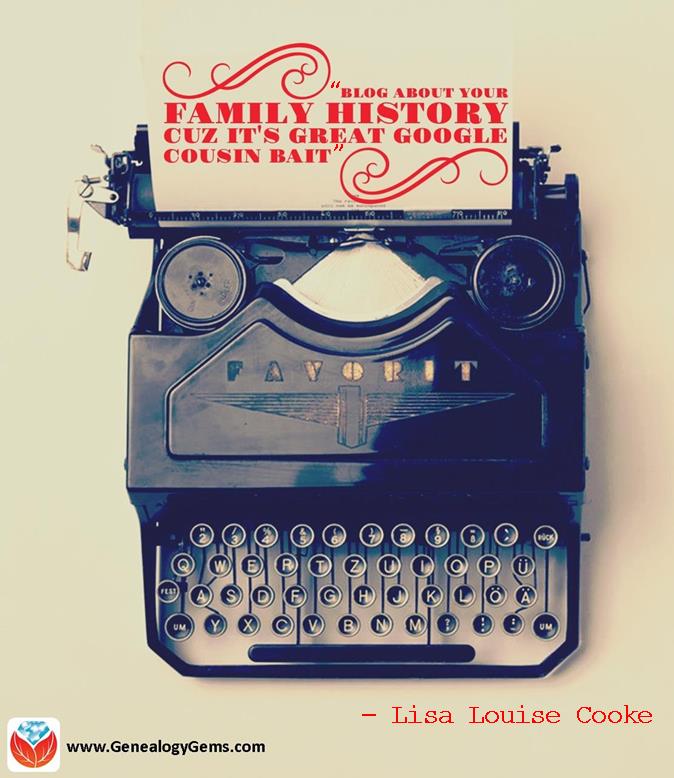 Using Google Earth for Genealogy
Using Google Earth for Genealogy
Using Evernote for Genealogy
How to Start a Family History Blog
 Those unfamiliar with Ireland research may assume this means local FamilySearch Family History Centers, but a map shows only a few of these in Ireland. I would start first with the network of county genealogy centers, accessible online at Roots Ireland. According to that site, “The county genealogy centres are based in local communities, working with volunteers, local historical societies, local clergy, local authorities, county libraries and government agencies to build a database of genealogical records for their county. By using this website you are supporting that work and the communities from which your ancestors originated.” Several counties actually already have online records you can access through the Roots Ireland link above. Ancestry also has several databases of Irish Catholic parish registers.
Those unfamiliar with Ireland research may assume this means local FamilySearch Family History Centers, but a map shows only a few of these in Ireland. I would start first with the network of county genealogy centers, accessible online at Roots Ireland. According to that site, “The county genealogy centres are based in local communities, working with volunteers, local historical societies, local clergy, local authorities, county libraries and government agencies to build a database of genealogical records for their county. By using this website you are supporting that work and the communities from which your ancestors originated.” Several counties actually already have online records you can access through the Roots Ireland link above. Ancestry also has several databases of Irish Catholic parish registers.











 If you enjoyed this post, you’ll love my series of DNA for genealogy quick guides. Each laminated guide–with quick, clear text that helps you act on what you learn–is targeted to a specific DNA topic, from “Getting Started” to the three types of DNA tests you can take to understanding your results with testing companies
If you enjoyed this post, you’ll love my series of DNA for genealogy quick guides. Each laminated guide–with quick, clear text that helps you act on what you learn–is targeted to a specific DNA topic, from “Getting Started” to the three types of DNA tests you can take to understanding your results with testing companies  Why not share the gift of family history story in this year’s Christmas letter or holiday cards?
Why not share the gift of family history story in this year’s Christmas letter or holiday cards?